| Class Image
|
Class Name
|
Details
|
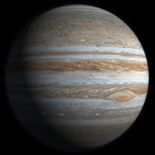
|
Class A - Gas Giant
|
Planets of this class are usually found in a star's outer or "cold zone". They are typically 140 thousand to 10 million kilometers in diameter and have high core temperatures causing them to radiate heat. Low stellar radiation and high planet gravity enables them to keep a tenuous surface comprised of gaseous hydrogen and hydrogen compounds.
|
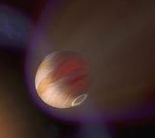
|
Class A-B - Pegasean
|
Planets of this class are found in a star's "hot zone". They are typically 140 thousand to 10 million kilometers in diameter and have high core temperatures causing them to radiate heat. The close proximity to their stars and high surface temperatures resulted in the moniker "hot Jupiters".
|
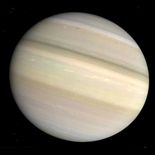
|
Class B - Gas Sub-Giant
|
Class B Planets are usually found in a star's outer or "cold zone". They are typically 50 thousand to 140 thousand kilometers in diameter and have high core temperatures but do not radiate much heat. Low stellar radiation and high planet gravity enables them to keep a tenuous surface comprised of gaseous hydrogen and hydrogen compounds.
|
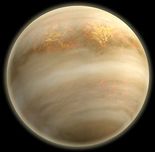
|
Class C - Reducing
|
Planets of this class are usually found in a star's "habitable zone". They are typically 10 to 15 thousand kilometers in diameter. They have high surface temperatures due to the "greenhouse effect" caused by their dense atmospheres. The only water found is in vapor form.
|
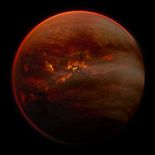
|
Class C-B - Thetusean
|
These are carbon-rich planets which are usually found in a star's "habitable zone". They are typically 12 to 28 thousand kilometers in diameter. There is substantial surface volcanic activity, and the atmosphere is quite dense and thick with dark clouds of hydrocarbon soot. The surface is extremely hot due to the very strong "greenhouse effect" caused by their dense atmospheres and the low albedo of the hydrocarbon clouds. The only water found is in vapor form (if it exists at all).
|
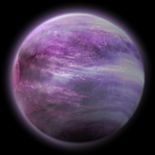
|
Class C-C - Amunian
|
Amunian worlds are usually found in a star's "habitable zone". They are typically 10 to 15 thousand kilometers in diameter. The atmospheres are very dense that retain large amounts of carbon monoxide and 'humid' with ammonia, the Greenhouse effect if quite predominant yet reduced over normal class C's due to the high albedo of the atmosphere. These worlds are capable of supporting liquid ammonia at higher temperatures because of the greater atmospheric pressure. Atmospheres may contain significant amounts of volcanic and possibly sulfuric gases, depending on the inherent geological activity of the planet. In addition large amounts of argon and iodine in the atmosphere cause the planet to have to an off pink atmospheric coloring and causes its clouds to appear a smoggy orchid color.
|
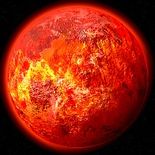
|
Class D - Geo-plastic
|
Planets of this class are usually found in a star's "habitable zone". They are typically 10,000 to 15,000 kilometers in diameter. They have a molten surface because they have been recently formed. The atmosphere contains many hydrogen compounds and reactive gases. Class D planets eventually cool, becoming class E.
|
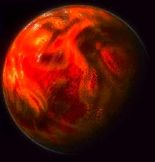
|
Class E - Geo-metallic
|
Planets of this class have a molten core and are usually found in a star's "habitable zone". They are typically 10,000 to 15,000 kilometers in diameter. Their atmospheres still contain hydrogen compounds. They will cool further eventually becoming class F.
|
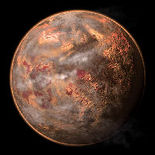
|
Class F - Geo-Crystalline
|
Class F planets are usually found in a star's "habitable zone". They are typically 10 to 15 thousand kilometers in diameter and have surfaces that are still crystalizing. Their atmospheres still contain some toxic gases. They will cool eventually becoming class C, G, H, J, K, M or N.
|
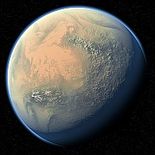
|
Class G - Desert
|
Planets of this class can be found in any of a star's zones, though usually in the habitable or hot zone. They are typically 8 to 15 thousand kilometers in diameter. Their surfaces are usually hot ( As frozen “desert worlds are usually classed as L or O instead ). Their atmospheres usually contain heavy gases and metal vapors, although exceptions where they contain a oxygen atmosphere are fairly common, although this is usually due to it being a former M Class world.
|
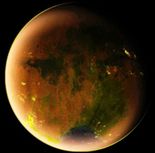
|
Class G-B - Xeric
|
Planets of this class can be found in any of a star's zones, though usually in the habitable or hot zone. They are typically 8 to 15 thousand kilometers in diameter. Their surfaces are usually hot but not as hot as a straight class G, they can be temperate leaning. There is typically a small amount of simple plant life. Small lakes of water may be found on the surface and there is generally a moderate amount of water just under the surface. Unlike a straight class G clouds dense enough to have rain can occur - although extremely rarely. Their atmospheres usually contains oxygen and nitrogen.
|

|
Class H - Geo-Thermal
|
Planets of this class are usually found in a star's "habitable zone" or "cold zone". They are typically 1,000 to 10,000 kilometers in diameter. They have partially molten surfaces and atmospheres that contain many hydrogen compounds. They cool becoming class L.
|
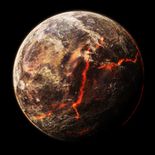
|
Class H-B - Hebean
|
Planets of this class are usually found in a star's "habitable zone" or "cold zone". They are typically 5,000 to 13,000 kilometers in diameter. These silicate-rich worlds are highly geologically active, but possess large regions of stability as well. The atmosphere can vary in thickness, with standing water typical only for those larger-massed bodies that have a high level of activity and a resulting thick atmosphere. The average age of the surface of these worlds is no more than a few million years old. Depending on how much ice they collected during their formation and/or from cometary impacts they will cool becoming class L, K or M-B.
|
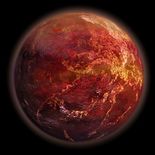
|
Class H-C - Idunnian
|
Planets of this class are usually found in a star's "habitable zone" or "cold zone". They are typically 5,000 to 11,000 kilometers in diameter. They have atmospheres that contain many hydrogen compounds and metalic vapors. They have partially molten surfaces which steams with rivers of copper, nickel and other metals leaving the planet to have a rusted or blood colored surface. They cool becoming class L.
|
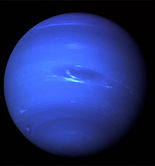
|
Class I – Ice Giant
|
Ice Giants are typically 30,000 - 100,000 kilometers in diameter. these
gaseous giants have vastly different compositions from other giant worlds; the core is mostly rock and ice surrounded by a tenuous layers of methane, water, and ammonia. Additionally, the magnetic field is sharply inclined to the axis of rotation. Class I planets typically form-on the fringe of a star system.
|
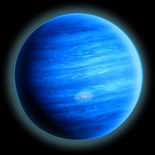
|
Class I-B – Ice Supergiant
|
Ice Supergiant are typically 100,000 - 2,000,000 kilometers in diameter. these
gaseous supergiants have vastly different compositions from other giant worlds; the core is mostly rock and ice surrounded by a tenuous layers of methane, water, and ammonia. Additionally, the magnetic field is sharply inclined to the axis of rotation. Class I-B planets typically form-on the fringe of a star system.
|
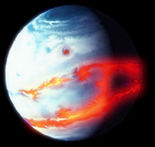
|
Class I-C – Spitzer
|
I-C – Spitzer type are typically 30,000 - 850,000 kilometers in diameter. These gaseous giants resemble class I/I-B in material and overall structure however their location in a stars hot zone results in exotic atmospheric effects such as "hot" solidified ices on I-C worlds with enough mass. The close proximity to their stars and high surface temperatures resulted in the moniker "hot Neptunes".
|
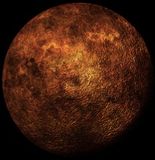
|
Class J – Geo-Morteus
|
Planets of this class are found in a star's "hot zone". They are typically 1,000 to 10,000 kilometers in diameter. They have high surface temperatures due to the proximity to their parent star. Their atmospheres are extremely thin at best with few chemically active gases.
|
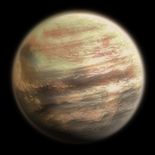
|
Class J-B – Helian
|
Planets of this class are found in a star's "hot zone". They are actually best described as a failed gas subgiant or gas giant, it is in the process of becoming a Class X - Chthonian world. They are typically 8,000 to 400,000 kilometers in diameter. They have high surface temperatures due to the proximity to their parent star and dense atmosphere. Their atmospheres are almost entirely made of helium, hydrogen, helium compounds with traces of methane, ammonia or acetylene. Class J-B's typically have a fairly strong magnetic field and as such can be quite useful for hiding space stations near the system's parent star.
|
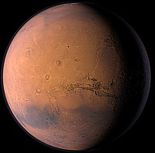
|
Class K – Adaptable
|
Planets of this class are usually found in a star's "habitable zone". They are adaptable for humanoid colonization through the use of pressure domes and other life support devices. They are typically 5,000 to 10,000 kilometers in diameter. They have thin atmospheres. Small amounts of water are present.
|
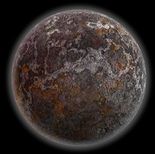
|
Class L - Geo-Inactive
|
Planets of this class are usually found in a star's "habitable zone" or "cold zone". They are typically 1,000 to 10,000 kilometers in diameter. Low solar radiation and minimal internal heat usually result in a frozen atmosphere.
|
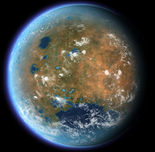
|
Class M - Terrestrial
|
Planets of this class are found in a star's "habitable zone". They are typically 10,000 to 15 thousand kilometers in diameter. They have atmospheres that contain oxygen and nitrogen. Life-forms are typically abundant. If water covers more than 80% of the surface, then they are considered class N. If water covers less than 40% of the surface, then they are considered class M-B.
|
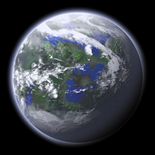
|
Class M-B - Marginal
|
Class M-B planets are typically rocky, forested worlds devoid of animal life. They are, however, well-suited for humanoid colonization and are prime candidates for terraforming. Water is typically scarce at least on the surface.
|
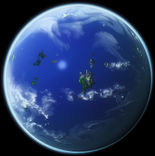
|
Class N - Pelagic
|
Class N planets are usually found in a star's "habitable zone". They are typically 10,000 to 15 thousand kilometers in diameter. They have atmospheres that contain oxygen and nitrogen. Life-forms are typically abundant. If water covers less than 80% of the surface, then they are considered class M.
|
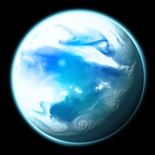
|
Class N-B - Poseidonic
|
Class N-B Planets are usually found in a star's "habitable zone". They are typically 8,000 to 20,000 kilometers. These worlds are plagued by massive storm systems which can take up whole hemispeheres for months at a time. They have global oceans tens to hundreds of kilometers deep, their atmospheres are extremely dense. The surface temperature can reach into the hundreds of degrees Fahrenheit and the surface evaporation and re-condensation is so high that the demarcation line between ocean and atmosphere is difficult to determine.
|
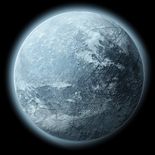
|
Class N-C - Europaic
|
Planets of this class are usually found in a star's "cold zone" They are typically 9,000 to 16,000 kilometers in diameter. These ocean worlds have their crusts frozen over due to a variety of reasons, most often a dimming sun. Tidal or subsurface geological stresses often create cracks in the global ice coverage, allowing a thin atmosphere of oxygen and nitrogen to form. Were it not for constant replenishment from these rifts, the atmosphere would desiccate within a few million years.
|
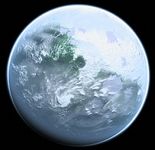
|
Class O - Glacial
|
Planets of this class are usually found in a star's "habitable zone" or "cold zone" They are typically 10,000 to 15,000 kilometers in diameter. Surface is typically covered with more than 80% by ice. Atmosphere is typically Nitrogen, oxygen, and element traces. Usually planets of this Class is are technically Class M or N that are just too far from its parent star or are going through an ice age.
|
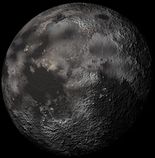
|
Class P - Planetoid
|
Planets of this class are usually found in a star's "habitable zone" or "cold zone" They are typically 100 to 4,000 kilometers in diameter. Surface varies but is usually barren and cratered. Atmosphere is typically only trace gasses. Many moons and asteroids are considered Class P. Most are not
suitable for humanoid life, though many can be colonized via pressure domes.
|
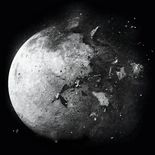
|
Class P-B - Aggregate
|
Planets of this class can be found in any of the star's zones. They are typically 300 to 2,500 kilometers in diameter. Class P-B planets are essentially debris piles, that is a "shattered planet" held together by mutual gravity; their shapes may change over time, subtly or obviously, due to gravitational flexing. Their composition may vary, but for the most part they tend to be silicate-rich.
|
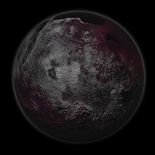
|
Class P-C - Vestian
|
Planets of this class are usually found in a star's "habitable zone" or "cold zone" They are typically 100 to 4,000 kilometers in diameter. Surface is barren and blackened from volcanic activity that ended long ago and is now heavily cratered. Their atmosphere eroded away long ago leaving only a thin covering of carbon dioxide and perhaps trace volcanic gasses. These worlds often contain high density silicates just under the surface.
|
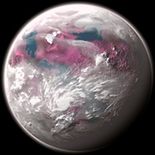
|
Class Q - Rogue
|
These planets do not orbit any star they are typically adrift in space, although may be stationary in a remnant nebula or asteroid belt. Planets of this class are usually found adrift in interstellar space, cometary halos or nebulae. They are typically 4,000 to 20,000 kilometers in diameter. Surface can in some rare cases be temperate due to geothermal venting. Atmospheric conditions are typically made up of volcanic gases or frozen. Small possibility for non-photosynthetic plants and related animal life.
|
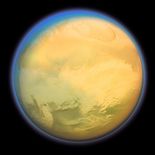
|
Class R - Promethean
|
Planets of this class are usually found in a star's "habitable zone" or "cold zone" They are typically 5,000 to 15 kilometers in diameter. Planets of this class have extremely dense atmospheres largely composed of nitrogen with methane and ethane clouds and a nitrogen-rich organic smog. They Typically have a seasonal system with storms which rain liquid methane and they may have some fairly active cryovolcanic activity.
|
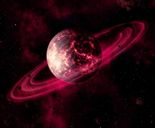
|
Class S - Phantasmagoric
|
Phantasmagoric worlds can be found in any of a stars zones, they are typically 8000 to 20000 kilometers in diameter. Phantasmagoric worlds are worlds covered in ashlands, swamp and volcanic landscape. In the deep ashlands of these worlds flaming ash cyclones can been seen.
|

|
Class T - Gas Super-giant
|
Planets of this class are usually found in a star's "cold zone". They are typically 10 to 50 million kilometers in diameter. They have high core temperatures causing them to radiate enough heat to keep water in a liquid state.
|
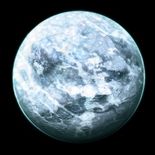
|
Class U - Tritonian
|
Planets of this class are usually found in a star's "cold zone" They are typically 1,000 to 10,000 kilometers in diameter. These are icy worlds which exhibit varying degrees of cryo-volcanic and other forms of geological activity. Atmospheres vary in thickness, but typically is quite thin, if present at all. Standing bodies of liquid methane or nitrogen are possible, although rare, typically being present only near cryo-thermal regions, and when the atmosphere is thick.
|
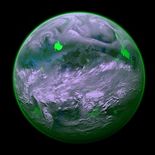
|
Class V - Nyxian
|
Planets of this class can be found in any of the star's zones. They are typically 5,000 to 10,000 kilometers. Surface is largely made up of hard barren brown or off blue rock with rivers of chlorine. Atmosphere is largely made up of Neon, Xenon, Radon, Ammonia and Chlorine and often has storm clouds of Ammonia and Chlorine. Due to the reactions with the active Radioluminescent particles in the atmosphere the planet is effectively a giant florescent "bulb" in space giving the entire planet an eerie green glow.
|
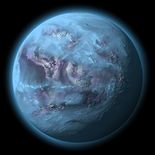
|
Class V-B – Picassean
|
Planets of this class are found in a star's "hot zone" or "habitable zone". They are typically 4,000 to 12,000 kilometers in diameter. Planets of this class are covered in a rich abundance of minerals and rivers of flowing mercury. In some situations fulminates will form where the mercury pools up and cause small explosions. Their atmospheres vary but typically are very poisonous with high levels of Mercury vapors, Mercury fluoride and Ammonia with colder planets of this class even possibly having mercury "snow". In some circumstances just the right gaseous mixture occurs and the planet gains periods of an unusual blue glow from the mercury acting as a florescent.
|
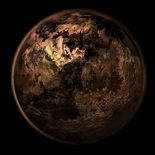
|
Class W - Sethian
|
These carbon-rich worlds can be found in any of the star's zones. They are typically 4,000 to 15,000 kilometers. If they are volcanic diamond rocks and dense metals may litter the surface. Atmosphere is typically highly toxic and corrosive, consisting largely of carbon monoxide, sulfur dioxide or methane. Geological features often arise that can be analogous to those of a Class M world, but with different contents such as Lakes and seas of methane, tar or other hydrocarbon sludge.
|
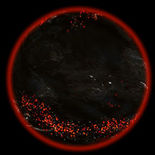
|
Class X - Chthonian
|
Class X planets are the result of a failed Class T or S planet in a star system's Hot Zone. Instead of becoming a gas giant or red dwarf star, a Class X planet was stripped of its hydrogen/ helium atmosphere. The result is a small, barren world similar to a Class J planet, but with no atmosphere and an extremely dense, metal-rich core. They are typically 1,000-10,000 kilometers in diameter.
|
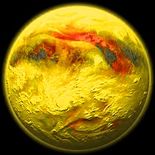
|
Class Y - Demon
|
Planets and planetoids of this class can be found in any of a star's zones. They are typically 10 - 15 thousand kilometers in diameter. Atmospheric conditions are often turbulent and saturated with poisonous chemicals and thermionic radiation. Surface temperatures can reach in excess of 500 K.
|
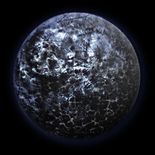
|
Class Z - Dead World
|
Planets of this class can be found in any of a star's zones. They are typically 4,000 to 15,000 kilometers in diameter. Class - Z worlds are utterly devoid of an ecosystem, atmosphere, or any form of native life. Planets of this class were originally habitable worlds but were devestated by apocalyptic events of some sort. The surface is typically heavily cratered and possibily radioactive.
|